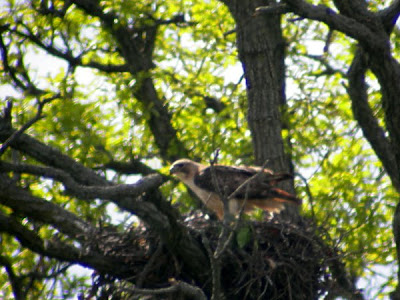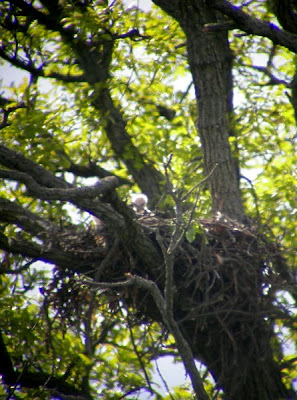
Photo by Marian Anderson
The Nest on Emerald Road.
Before my last trip to New York City, it had become clear that the Red-tail Nest on County Rd. M was not active. This was a huge disappointment as I didn't know of any other nests that could be viewed from a public access area and the Ms didn't seem have graced us the second time around with a different but observable nest.
Therefore I asked all my friends and acquaintances to please keep an eye peeled for nests. And not only that but to actively ask around whenever they were in groups of people for tips.
Well, Suzan Wade and Marian Anderson who were taking daily trips through the countryside took me at my word and scrutinized every tree they came across and TA DA! They spotted two possible nests but weren't sure that either was truly active though an RT had been seen near one of the nests.
Marian and I went out today to find out. Beyond spotting this particular nest Marian had run across the man farming it and had asked permission to go onto the land as the nest was quite far off the road. The farmer replied he'd ask the man who actually owned the land if it was okay, he'd also let the niece down the road that kept an eye out for trespassers that we had permission. Which was a huge help on Marian's part. She promised we wouldn't tromp across the planted areas and we won't.
Many thanks to the landowners for being so generous with access and trusting us not to do any harm.
All that done, we weren't even clear as to whether this was an old nest, an alternative nest, or was the real deal for this season but we were out to find out.
I tried to prepare myself not to be too disappointed if it was another dead end.

The first tickle of excitement occurred when I got magnification on the nest and saw that there were twigs with reasonably fresh leaves.

WAIT!! Stop the presses. Is that a little fluffy head in the far back corner of the nest on the left?

And just then a head and torso popped up center. Hurray!! An active nest and permission to watch it, with at least two eyasses.

Two eyasses immediately jump on each other and start rough housing. Wow, these eyasses are more mature than those at the Cathedral look at the dark pin feathers on the wing.

Suddenly everyone disappears from sight.

And for good reason, if you don't want your head accidentally taken off. Here comes Mom with possible vittles. Our presence has not escaped her notice.
By the way we are not close. We're the same distance away as is visible in the top photograph.

Mom leaves and a head pops up.

Now eyass stares at us.

A second eyass decides to walk over the first.

Second eyass flips round and dislodges first eyass.

More staring.

What now?

Did Mom bring food? And if so, is a third eyass eating it?
Photo by Marian Anderson
We haven't moved in particular, only curved round the corner of the field but we must have crossed an invisible boundary as one of the parents appears and begins to fly back and forth and scream. County hawks are touchy.
We haven't moved in particular, only curved round the corner of the field but we must have crossed an invisible boundary as one of the parents appears and begins to fly back and forth and scream. County hawks are touchy.

Parent must have decided that as we aren't going any further it's okay because the screaming stops and no pass overs are made. Actually she could have been screaming at something else all together for all we know as we are still very far from the nest.

The two in the back look like they might be eating now.
Photo by Marian Anderson
Parent decides to fly off.
Parent decides to fly off.

As they seem to be hunkered down and likely will nap after eating we decide to go back to the car and go check on the second possible active nest.

As we head down the road about 50 yards, a hawk comes out of an Oak hard by the verge, takes a look at us.

Then he heads for the horizon. Dad?

Which brings us to a pair of geese and their three goslings, I got out to look at.

Further down the road I get out again. the number of goslings these two have in tow is truly remarkable.
It occurs to me that perhaps several sets were orphaned and just joined the throng. Cathy Horvath did say that ducks down't count so maybe geese don't either. It's still weird.
Do Canada Geese do communal gosling sitting. Not that I know of. Did another pair swim by and somehow their goslings got sucked into the other group?
Do Canada Geese do communal gosling sitting. Not that I know of. Did another pair swim by and somehow their goslings got sucked into the other group?
then I notice the gosling-less pair. Did they just go by and loose their train?
Eventually Marian and I make our way to a farm owned by Suzan Wade's family where the other nest had been sighted. The field the trees bordered was fallow so we didn't have to worry about crop tromping but it had a dandy crop of thistles and stickers going.
The trees had leafed out fully since Marian had seen the nest so it took a few minutes to rediscover it.
It turned out to be rather mysterious as it was heavily leaved and not at all easy to view. And then I noticed the white somethings outside the nest. Note the tail hanging down. It didn't act right for a Red-tail eyass it seemed more plume like in the breeze.


We made several attempts at different angles and never really did figure out what we had here. It was beginning to get dark and whethter the light was an issue or whether the nest looked slightly differently put together than that of an RTH nest because of it, I don't know.
We'll be going back to check on it but if anyone has any bright ideas, send them along.
Donegal Browne






2 comments:
Do Canada geese parents have to feed goslings, or do the goslings forage for themselves? I looked it up and one site said goslings eat insects and the tips of greenery.
Because I am thinking try to feed 28 might not work, but those goslings look quite big and healthy. So maybe they were adopted/babysat at a fairly advanced age.
I am thinking that white thing is maybe a plastic big, sigh.
Goslings and ducklings when hatched are good to go in the feeding themselves department. The parent's job is to protect them from predators and show them the ropes on where good pickings might be found in the area until they aren't quite such perfect tasty mouthfuls for so many other creatures.
In the photographs you may note the other pair of geese who have no goslings with them. I was wondering if the pairs had passed close by each other and the two sets or perhaps two sets and a few more had gotten intermingled somehow and never reseparated. I don't know how one pair of geese would take to another pair swimming by and herding half of what they must think is their personal brood away from them.
Ah ha, maybe that is a big white plastic bag up there. I hadn't thought of that! Thanks Karen.
Post a Comment